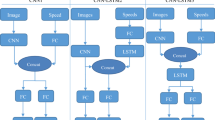Abstract
This paper considers to make a small-scale car composed of low-cost hardware components acquire autonomous driving tasks by using deep learning. The tasks to be acquired are assumed to be used for indoor patrols of mobile robots, and are given as a series of tasks, where the car proceeds along the walls of a narrow corridor and stops in front of the target object. The tasks include a three-point turn as a difficult task. The difficulties in the tasks are that different actions are required even for similar input camera images and that the acceleration value cannot be kept at zero when stopped. To deal with these difficulties, we propose models outputting the state of the car in addition to steering and throttle values, models with throttle value of one step before in addition to an image, and improved long short-term memory (LSTM) models with/without additional input and output. Our experiments demonstrate that the proposed LSTM models with three output and additional input achieve a 100% success rate until just before the goal.












Similar content being viewed by others
Explore related subjects
Discover the latest articles, news and stories from top researchers in related subjects.References
Badue C et al (2019) Self-driving cars: a survey. arXiv:1901.04407v2
Bojarski M et al. (2016) End to end learning for self-driving cars. arXiv:1604.07316v1
Du S, Guo H, Simpson A (2019) Self-driving car steering angle prediction based on image recognition. arXiv:1912.05440v1
Tzafestas SG (2018) Mobile robot control and navigation: a global overview. J Intell Robot Syst 91:35–58
Huang BQ, Cao GY, Guo M (2005) Reinforcement learning neural network to the problem of autonomous mobile robot obstacle avoidance. In: International conference on machine learning and cybernetics, pp 85–89
Ganapathy V, Yun SC, Joe HK (2009) Neural Q-learning controller for mobile robot. In: 2009 IEEE/ASME international conference on advanced intelligent mechatronics, pp 863–868
Jing Y, Chen Y, Jiao M, Huang J, Niu B, Zheng W (2019) Mobile robot path planning based on improved reinforcement learning optimization. In: International conference on robotics systems and vehicle technology, pp 138–143
Donkey Car—An opensource DIY self driving platform for small scale cars. https://www.donkeycar.com/. Accessed 13 Dec 2020
Bechtel MG et al (2018) Deeppicar: a low-cost deep neural network-based autonomous car. In: IEEE international conference on embedded and real-time computing systems and applications, pp 11–21
Thomas A, Hedley J (2019) FumeBot: a deep convolutional neural network controlled robot. Robotics 8(3):62
Brooks RA (1986) A robust layered control system for a mobile robot. IEEE J Robot Autom 2(1):14–23
Kurt TE (2006) Hacking Roomba: ExtremeTech. Wiley Publishing, Indianapolis
Colledanchise M, Ögren P (2018) Behavior trees in robotics and AI: an introduction. CRC Press, Boston
Fukuoka R et al (2020) Proposal of CNN models for acquiring stop and turn motion of self-driving model car. In: The twenty-fifth international symposium on artificial life and robotics 2020, pp 371–375
Lecun Y, Bottou L, Bengio Y, Haffner P (1998) Gradient-based learning applied to document recognition. Proc IEEE 86(11):2278–2324
Kingma DP, Ba J (2014) Adam: a method for stochastic optimization. arXiv:1412.6980v9
Acknowledgements
This work was supported by JSPS KAKENHI Grant Number 20K11994.
Author information
Authors and Affiliations
Corresponding author
Additional information
Publisher's Note
Springer Nature remains neutral with regard to jurisdictional claims in published maps and institutional affiliations.
This work was presented in part at the 26th International Symposium on Artificial Life and Robotics (Online, January 21–23, 2021).
About this article
Cite this article
Fukuoka, R., Shigei, N., Miyajima, H. et al. Self-driving model car acquiring three-point turn motion by using improved LSTM model. Artif Life Robotics 26, 423–431 (2021). https://doi.org/10.1007/s10015-021-00697-9
Received:
Accepted:
Published:
Issue Date:
DOI: https://doi.org/10.1007/s10015-021-00697-9




